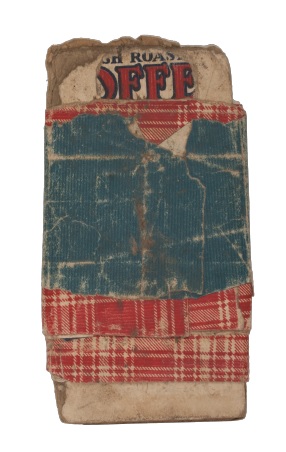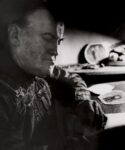
James Castle
American, 1899-1977
Figure in Blue Coat and Plaid, n.d.
found paper, wheat paste
5 1/2 x 2 7/8 in.
James Castle Collection and Archive

James Castle working at his desk (photograph housed at the James Castle Collection and Archive)

Castle - Woman In Blue Coat and Red Plaid Skirt
COMMENTS
Castle's Soot and Spit
James Castle’s development of his own wonderfully personalized drawing medium utilizing stove soot links him to centuries-old artistic practices. Castle is known to have used the soot collected from the family’s wood-burning stove; later, when they turned to other heating and cooking sources, he had to rely on family members to collect soot for him that was of a usable quality.
To clarify, soot has been described as the black particulate heating or combustion products of organic materials such as wood, paper, coal, oils, or resins. Although the composition of soot can vary widely, it consists primarily of amorphous carbon along with highly crystalline carbon, soluble organic compounds, and inorganic material. Two distinct types of soot were found among the contents of Castle’s studio. The first, stored in a large plastic Albertson’s ice cream tub, consists of fine, powdery, carbonaceous particles with a slightly greasy feel. This soot visually resembles a traditional carbon black pigment such as lampblack. While we cannot be sure exactly how Castle prepared his drawing ink, experiments to replicate it using a mixture of this fine particulate soot and saliva produced a workable ink. No grinding was required, but the soot had to be worked up well with the fingertip or a similar tool, as the somewhat greasy material resisted easy mixing with the aqueous liquid. A second, coarse sooty material stored in a coffee can proved unsuitable for making a drawing ink.
Bringing Color into the Picture
Although Castle is perhaps best known for his soot-and-spit renderings in subtle shades of gray and black, color appears in a large number of his drawings. The artist used color to fill in forms or to provide distinct highlights within drawings that were predominantly of soot and spit, or as a major component in a composition. Alternatively, the soot itself may exhibit subtle tonal variations, ranging from warm brown to cooler blue lines and washes. But it is Castle’s bold full-color drawings executed on supports fashioned from wax-coated food cartons that are the most mystifying and challenging when it comes to discerning his sources of color and methods of application. These are often referred to as “colored pulp” pieces, based on the misconception that the artist wet and pulped colored paper, and then applied and left the pulp on the drawing support; however, no evidence of this was observed. Intense, bold colors often dominate in these works, but the exact design materials employed are difficult to determine. Did Castle use mediums typically dispersed with water, such as watercolor, or other commercial mediums, possibly chalk or colored crayon, that were amenable to softening with water and smudging with a finger or cloth? Or did some of the colors originate in more unconventional sources?
Materials retrieved from Castle’s workroom and now stored in the archive of the J Crist Gallery offer clues to the colored works and a resource for further study. Among them is an unexpected variety of commercial art materials: jars of tempera paint, soft oil pastels, harder school-type chalks, colored pencils, and wax crayons (some retaining their Crayola or Little Lulu wrappers), as well as brightly colored crepe paper. Equally significant was the discovery of numerous bunched and twisted wads of paper, cotton, or cotton wrapped in cloth, each wad saturated with soot or color. Also preserved were several face makeup containers, one labeled “Sophisti-creme by du Barry - champagne beige” and another (unlabeled) with a twisted wad of cheesecloth and cotton pressed into the remaining makeup and saturated with it from apparent use. The resemblance of this unconventional “medium” to the flesh tones of a number of Castle’s drawn figures, is noteworthy; if indeed used, it is a remarkable and clever artistic choice.
Close observation of his full-color drawings revealed that Castle, rather than applying and leaving the pulp from colored tissue paper or crepe paper on the surfaces of his drawings, used a method comparable to that employed in his soot-and-spit drawings. It appears that he sometimes dampened and then squeezed liquid colorant from such papers into some kind of container, which he then applied to the drawing support using his wads or sticks; in other instances, he rubbed the dampened colored paper directly onto the support surface, transferring the soluble color. The highly water-soluble synthetic dyes frequently used in the manufacture of tissue paper certainly would have provided a good and ready source of bright, clear color. Wadded pieces of orange and red crepe papers were found among Castle’s materials, well-worn and depleted of color, consistent with such use. In addition, color squeezed from an unused sample of Castle’s bright red crepe paper was found to be strikingly similar to the color present in many of his works, including drawings in one of his books, and experimentation showed it could be applied with a stick in a fashion simulating his method. ...
In examining Castle’s repertoire of found mediums, one unexpected discovery was that he most likely used the common household product laundry bluing as a prominent colorant in his work. Laundry bluing is a concentrated, intensely blue commercial product used to optically “brighten” dingy or yellowed linens or other fabrics. Visual inspection of Castle’s drawings revealed a particularly intense blue color occurring again and again. In one of his books, for example, he used this blue much as one would use ink, applying it with a sharpened stick in the same fashion as he applied the medium in his ubiquitous soot-and-spit drawings. In a drawing depicting four figures standing in a row, the same intense blue color appears in both crisp stick-applied lines and passages of wash. The artist even filled in broad areas of folded cardboard on one of his figure constructions with this blue, creating a richly colored outer garment ("Woman in Blue Coat and Red Plaid Skirt"). The amount, consistency, and uniformity of the blue colorant suggest a commercial source, easily consistent with bottled laundry bluing.
The use of commercial laundry bluing as an artists’ colorant has long been known to conservators of ethnographic objects. A household product widely distributed during the twentieth century, it has been incorporated into the palettes of artists and craftspeople from many parts of the world, including the American Southwest and Northwest, Mexico, and the Pacific Islands, as well as Africa and India. It would not be surprising to find such a readily available and inexpensive source of color among Castle’s eclectic stock of materials.
The two most common colorants used in commercial laundry bluing during the past century were Prussian blue and artificial ultramarine. Microscopic samples of the blue taken from several of Castle’s works were analyzed and compared with mid-century examples of two prominent brands. The results of scientific analysis are consistent with the use of laundry bluing containing Prussian blue pigment. Unfortunately, since Prussian blue and other pigments and dyes found in laundry bluing are also present in traditional artists’ materials, definitive identification of this product in Castle’s color works is difficult in the absence of corroborating evidence.
Close examination of Castle’s drawings and constructions further revealed his occasional use of a range of other commercially manufactured mediums, such as fiber-tipped and ballpoint pens, colored wax crayons, graphite pencils, and even green finger paint. Colored fiber-tipped (or felt-tipped) markers, more commonly known by the prominent brand name Magic Markers, were often employed as discrete accents in Castle’s constructions, placing the dates of these pieces at mid-century or later. Ballpoint pen occasionally appears in his drawings as a design material but most often was used only for his infrequent signatures.
Drawing Implements: Sticks and Wads
Just as the sources of Castle’s drawing mediums were often unconventional, so too were the tools he used for their application. No brushes were found among his possessions, nor is there any mention of their use in previous writings or in recorded family recollections, yet he applied his Washes with skill and nuance. Only an occasional metal pen nib was encountered among his things, but throughout the boxes of his materials are wooden sticks of various shapes and sizes that he used to deftly render his personal vision of Idaho life. Artists have always selected their pens (quills, reeds, or metal nibs) for the distinctive quality of the line they deliver. Similarly, Castle individually carved sticks to produce the surprising variety of lines he desired. Round or flat sticks, wood slats, and rough twigs were cut, carved, and whittled—some to sharp points, others to a more gradual taper, and still others to mere stubs. Many of Castle’s preserved sticks remain saturated with color, often black or of an indeterminate muddy tone but occasionally of an intense red or blue. Nails, too, are present, the heads and points also used to deliver color to the page.
For the application of washes it appears that Castle preferred to use “wads” of cotton, paper, or cloth-wrapped cotton, all of which were encountered frequently among his archived ephemera. A number of wads - of crepe paper, thin tissue, or simply cotton - were found nestled in a cherry cordial box like favorite candies. Most of the preserved wadded materials, however, seem to consist of cotton around which a thin open-weave cloth had been wrapped and deliberately rolled and twisted to create a compact tool Castle could grasp firmly between his fingers, dip into his wash (or, alternatively, rub into a dry medium), and then apply to his drawing with confident, controlled strokes. A possible source for this wrapping material was found among his possessions: a circular disk consisting of many layers of white open-weave cloth (perhaps a coffee filter), from which he may have peeled away layers for enfolding the cotton wads prior to use.
- Nancy Ash and Scott Homolka, “Observations on James Castle’s Materials and Techniques”, in Percy, Ann Ed., James Castle: A Retrospective, Philadelphia Museum of Art, 2008, 157-164
SBMA CURATORIAL LABELS
While it may be argued that Castle’s soot drawings are the most. sophisticated artworks in his extensive oeuvre, he seems to have been no less active, and certainly reveled no less, in creating paper constructions of humans and animals. Much of the pleasure for the artist was in the labor itself, probably akin, in his mind, to the honorable and diligent activities of folding, pasting, and binding that he observed in his parents’ post office. These "friends of Jim" as family members referred to them, were assembled from found paper, cardboard, and fabric and held together with wheat paste and string. It is unclear whether some may have been intended to portray specific people or whether he saw them as particular characters or "types." One of those displayed nearby, clad in a blue coat and plaid, humorously has a face made from coffee packaging. When seen from a distance, an illusion is created, whereby the letters forming part of the word "coffee" appear as two cartoonish eyes looking upward to the left. Another figure. clad in black, ominously has a dark spot where the face should be. Apparently, this impenetrable. sentry-like being held some sort of special meaning for Castle, as it is represented attached to a wall, in many drawings. The strange presence must remain a cipher, despite the temptation to read the figure – deaf, mute, and blind – somehow in relation to its creator, if not an alter ego, then at least an archetype or companion, also partly sealed off from the world.
- The Private Universe of James Castle, 2023
